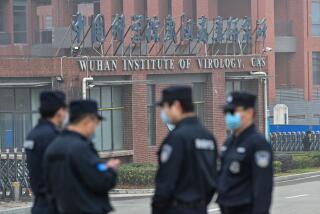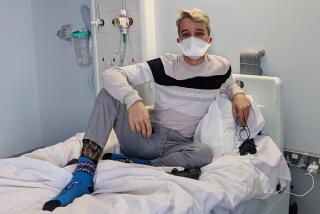American Ebola patients become serum test subjects
- Share via
There is no vaccine or proven treatment for patients stricken with Ebola, but two ailing Americans who were infected with the deadly virus while working in the West African nation of Liberia have become test subjects for an experimental serum that they received with the help of two U.S. health agencies.
In a rare move, the Centers for Disease Control and Prevention and the National Institutes of Health played an informal role in connecting the Christian aid group Samaritan’s Purse to Mapp Biopharmaceutical Inc., the San Diego pharmaceutical firm that developed the treatment.
The drug, called Zmapp, had never been tested in humans, according to a company statement released Monday.
Only three doses of the serum had been produced, said Dr. Anthony Fauci, head of the National Institute of Allergy and Infectious Diseases. Two of those doses were provided to the American patients, Dr. Kent Brantly and missionary Nancy Writebol.
“This was the first time it was put into humans, because all the previous work was done on animals and the results had been encouraging,” Fauci said.
Details about the serum emerged as a New York hospital performed tests on a patient with a possible Ebola infection and the World Health Organization said the virus had now claimed at least 887 lives in Africa, including 61 deaths in just two days.
The new WHO figures indicate the disease is picking up speed. The count of 163 new Ebola cases on July 31 and Aug. 1 was 33% higher than the 122 cases reported over the four-day period that ended July 27.
Brantly, who was working in Africa under the auspices of Samaritan’s Purse, became the first confirmed Ebola patient to be treated on American soil when he was admitted to Emory University Hospital in Atlanta on Saturday. Writebol is expected to join him there Tuesday after being flown from Liberia in a specially outfitted air ambulance.
Writebol’s husband, David, said her condition had improved and she recently requested coffee and Liberian potato soup, “one of her favorite dishes,” according to SIM USA, the Christian organization with which Writebol serves.
“We are so grateful and encouraged to hear that Nancy’s condition remains stable and that she will be with us soon,” said Bruce Johnson, the organization’s president.
Ebola virus infection typically begins with flu-like symptoms, such as achy muscles, fever and malaise. As the disease progresses, patients suffer bleeding, rashes, vomiting and diarrhea. If the patients do not receive proper medical care, they can suffer deadly organ failure from the loss of fluids. The disease is fatal in 45% to 90% of cases.
The Zmapp serum is one of several drugs being developed for Ebola patients. But “very little of the drug is currently available,” according to Larry Zeitlin, president of Mapp Biopharmaceutical.
The drug is a cocktail of three “humanized” monoclonal antibodies that are manufactured in a group of fragrant plants or bushes known by the genus name Nicotiana.
Monoclonal antibodies fight viral invaders by locking onto antigens — projections on the surface of a virus that are used to cling to and then enter target cells in the body.
In the case of the Ebola virus, these antigens project like spikes from the virus’ long, spaghetti-like body.
Once these antigens lock onto the surface of a cell, the virus enters and uses the host cell’s machinery to begin mass-producing copies of itself. Antibodies, which can be produced by the immune system or administered as a drug, thwart the ability of antigens to lock onto target cells.
In tests conducted with the United States Army Medical Research Institute of Infectious Diseases in Frederick, Md., scientists infected rhesus macaques with Ebola and then treated them with the drug cocktail.
In one experiment, two animals that received the treatment within one hour of infection survived, while two untreated animals that served as controls died. In another experiment, four of the six animals that were treated 48 hours after infection survived while both of the control animals died, according to a 2012 report in the Proceedings of the National Academy of Sciences.
Under normal circumstances, the drug would need to be tested for safety and efficacy in humans before being approved by the Food and Drug Administration and used to treat patients. But Writebol and Brantly received it shortly after they became infected with Ebola.
A scientist from the National Institutes of Health was aware of the serum and helped members of Samaritan’s Purse get in touch with the San Diego company that makes it, according to the National Institute of Allergy and Infectious Diseases.
The aid group initially reached out to CDC officials working in Liberia to discuss the status of the experimental treatments they were aware of. Those officials put the group in touch with the NIH scientist, who was assisting in the Ebola outbreak response in West Africa.
“The scientist was able to informally answer some questions and referred them to appropriate company contacts,” NIAID said. “She was not officially representing NIH and NIH did not have an official role in procuring, transporting, approving or administering the experimental products.”
A report on CNN said the drug prompted a “miraculous” recovery and that Brantly’s condition improved within an hour, according to an unnamed source that cited a doctor involved in Brantly’s treatment. But that account was greeted with skepticism by longtime Ebola virus researchers.
“I would be ecstatic if Larry’s product helped save these people, but I also need to be extremely cautious,” said Thomas Geisbert, a professor of microbiology and immunology at the University of Texas Medical Branch at Galveston.
“To say the whole thing cleared up in an hour, that doesn’t happen in reality,” Geisbert said. “That’s like something that happens in a movie.”
Fauci said it was hard to say whether or not the medication had been effective.
“If you ask [CNN medical correspondent] Sanjay Gupta, he says the effect was dramatic, but when you have one patient, you have nothing to compare it to,” Fauci said. “You can’t make a definitive statement.”
In New York, the suspicious patient came to the emergency room of Mount Sinai Hospital early Monday with a high fever and gastrointestinal symptoms. Within seven minutes he was whisked into an isolation unit, where he will remain until test results are complete, a process that takes 24 to 48 hours, the hospital said.
Dr. Jeremy Boal, the hospital’s chief medical officer, said it was unlikely the man had Ebola. “It’s much more likely … a more common condition,” he said Monday.
Twitter: @montemorin
Times staff writers Tina Susman in New York and Christine Mai-Duc in Los Angeles contributed to this report.







